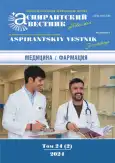Изучение использования в педиатрической практике лекарственных препаратов аптечного изготовления
- Авторы: Дударенкова М.Р.1, Солонинина А.В.2, Евстифеева Г.Ю.1, Горбунова Е.С.1, Нигматуллина Ю.У.1
-
Учреждения:
- ФГБОУ ВО «Оренбургский государственный медицинский университет» Минздрава России
- ФГБОУ ВО «Пермская государственная фармацевтическая академия» Минздрава России
- Выпуск: Том 24, № 2 (2024)
- Страницы: 56-60
- Раздел: ОРГАНИЗАЦИЯ ФАРМАЦЕВТИЧЕСКОГО ДЕЛА
- URL: https://journals.rcsi.science/2410-3764/article/view/280516
- DOI: https://doi.org/10.35693/AVP618048
- ID: 280516
Цитировать
Полный текст
Аннотация
Цель – изучение использования в педиатрической практике лекарственных препаратов, изготовленных в аптеке.
Материал и методы. Объектами исследования стали официальные веб-сайты, информация из рецептурного журнала производственной аптеки, инструкции по медицинскому применению лекарственных препаратов. Использовались контент-анализ, систематизация, обобщение, группировка и сравнение.
Результаты. По амбулаторным врачебным назначениям экстемпоральных лекарственных препаратов педиатрическим пациентам выявлены основные возрастные категории (дети от 1 месяца до 1 года и от 10 до 12 лет). Детям от 1 месяца до 1 года выписывались порошки из готовых лекарственных препаратов промышленного производства (таблеток), содержащих адреноблокаторы в 48% случаев (преимущественно пропранолол), диуретики – в 31% (спиронолактон), ФДЭ5-ингибиторы – в 6% (силденафил). Рецепты детям от 10 до 12 лет содержали в 97% случаев назначение глазных капель с атропина сульфатом из фармацевтической субстанции.
Выводы. Изучение врачебных назначений подтверждает индивидуальный подход в лечении пациентов педиатрического профиля и обосновывает необходимость аптечного изготовления лекарственных препаратов.
Ключевые слова
Полный текст
Открыть статью на сайте журналаОб авторах
М. Р. Дударенкова
ФГБОУ ВО «Оренбургский государственный медицинский университет» Минздрава России
Автор, ответственный за переписку.
Email: dfarm88@mail.ru
ORCID iD: 0000-0002-0731-6185
канд. фарм. наук, доцент, доцент кафедры управления и экономики фармации, фармацевтической технологии и фармакогнозии
Россия, ОренбургА. В. Солонинина
ФГБОУ ВО «Пермская государственная фармацевтическая академия» Минздрава России
Email: soloninina@mail.ru
ORCID iD: 0000-0002-2745-7698
д-р фарм. наук, профессор, заведующая кафедрой управления и экономики фармации
Россия, ПермьГ. Ю. Евстифеева
ФГБОУ ВО «Оренбургский государственный медицинский университет» Минздрава России
Email: gal-evst@mail.ru
ORCID iD: 0009-0006-9982-4414
д-р мед. наук, профессор, заведующая кафедрой педиатрии
Россия, ОренбургЕ. С. Горбунова
ФГБОУ ВО «Оренбургский государственный медицинский университет» Минздрава России
Email: gorbunova_ekaterina_sergeevna@mail.ru
ORCID iD: 0000-0002-2674-1304
старший преподаватель кафедры управления и экономики фармации, фармацевтической технологии и фармакогнозии
Россия, ОренбургЮ. У. Нигматуллина
ФГБОУ ВО «Оренбургский государственный медицинский университет» Минздрава России
Email: poet200707@mail.ru
ORCID iD: 0000-0002-3002-4519
старший преподаватель кафедры управления и экономики фармации, фармацевтической технологии и фармакогнозии
Россия, ОренбургСписок литературы
- Grigorev KI, Vyhristyuk OF. Medicines and children. The problems of the 21th century and search for their solutions. Medicinskaya sestra. 2020;22(1):5-13. (In Russ.). [Григорьев К.И., Выхристюк О.Ф. Лекарства и дети. Проблема XXI века. Медицинская сестра. 2020;22(1):5-13]. DOI: https://doi.org/10.29296/25879979-2020-01-02
- Abarca Lachén E, Hernando Martínez P, Gilaberte Calzada Y, et al. The Most Useful Pharmaceutical Formulations (Individualized Medications) in Pediatric Dermatology: A Review. Actas Dermosifiliogr (Engl Ed). 2021;112(4):302-313. DOI: https://doi.org/10.1016/j.ad.2020.11.006
- Grigorev KI, Haritonova LA, Vyhristyuk OF, et al. Peculiarities of drug therapy in pediatrics: help of a nurse in organizing medical care for children. Medicinskaya sestra. 2022;24(1):3-14. (In Russ.). [Григорьев К.И., Харитонова Л.А., Выхристюк О.Ф., и др. Особенности лекарственной терапии в педиатрии: роль медицинской сестры в организации эффективной медицинской помощи детям. Медицинская сестра. 2022;24(1):3-14]. DOI: https://doi.org/10.29296/25879979-2022-01-01
- Ernest TB, Craig J, Nunn A, et al. WHO essential medicines for children 2011-2019: age-appropriateness of enteral formulations. Arch Dis Child. 2022;107(4):317-322. DOI: https://doi.org/10.1136/archdischild-2021-321831
- Rieder M. Pharmacy and pediatric drug therapy: The key to safe and effective treatment for children. American Journal of Health-System Pharmacy. 2019;76(19):1452-1453. DOI: https://doi.org/10.1093/ajhp/zxz171
- Telnova EA, Plesovskih AV, Zagorujchenko AA. About features and challenges with medicines for children. Bulletin of Semashko national research institute of public health. 2020;3:28-35. [Тельнова Е.А., Плесовских А.В., Загоруйченко А.А. Об особенностях и проблемах с лекарственными средствами для детей. Бюллетень Национального научно-исследовательского института общественного здоровья имени Н.А. Семашко. 2020;3:28-35]. DOI: https://doi.org/10.25742/NRIPH.2020.03.004
- Lebedev MV, Abdullina YuA, Zaharova IYu. Irrational use of medicines in medical organizations of the Volga federal district (on the example of the Penza regional clinical hospital named after N. N. Burdenko, when providing specialized care to children in the conditions of the adult department of oral and maxillofacial surgery). Medical & pharmaceutical journal "Pulse". 2021;23(5):168-175. [Лебедев М.В., Абдуллина Ю.А, Захарова И.Ю. Нерациональное использование лекарственных средств в медицинских организациях Приволжского федерального округа (на примере ГБУЗ Пензенская областная клиническая больница им. Н.Н. Бурденко, при оказании специализированной помощи детям в условиях взрослого отделения челюстно-лицевой хирургии). Медико-фармацевтический журнал «Пульс». 2021;23(5);168-175]. DOI: https://doi.org/10.26787/nydha-2686-6838-2021-23-5-168-175
- Narkevich IA, Nemyatyh OD, Medvedeva DM, et al. Organizational and pharmaceutical aspects of improving medicinal provision of children (on the example of St. Petersburg). Journal of Siberian Medical Sciences. 2020;1:31-43. [Наркевич И.А., Немятых О.Д., Медведева Д.М., и др. Организационно-фармацевтические аспекты совершенствования лекарственного обеспечения детей (на примере Санкт-Петербурга). Journal of Siberian Medical Sciences. 2020;1:31-43]. DOI: https://doi.org/10.31549/2542-1174-2020-1-31-43
- Lopalco A, Denora N. Paediatric Formulation: Design and Development. Int J Mol Sci. 2020;21(19);7118. DOI: https://doi.org/10.3390/ijms21197118
- Lee SSY, Mackey DA, Lingham G, et al. Western Australia Atropine for the Treatment of Myopia (WA-ATOM) study: Rationale, methodology and participant baseline characteristics. Clin Exp Ophthalmol. 2020;48(5);569-579. DOI: https://doi.org/10.1111/ceo.13736
- Lee SS, Lingham G, Blaszkowska M, et al. Low-concentration atropine eyedrops for myopia control in a multi-racial cohort of Australian children: A randomised clinical trial. Clin Exp Ophthalmol. 2022;50(9);1001-1012. DOI: https://doi.org/10.1111/ceo.14148
- Wei S, Li SM, An W, et al. Safety and Efficacy of Low-Dose Atropine Eyedrops for the Treatment of Myopia Progression in Chinese Children: A Randomized Clinical Trial. JAMA Ophthalmol. 2020;138(11);1178-1184. DOI: https://doi.org/10.1001/jamaophthalmol.2020.3820
- Yam JC, Zhang XJ, Zhang Y, et al. Effect of Low-Concentration Atropine Eyedrops vs Placebo on Myopia Incidence in Children: The LAMP2 Randomized Clinical Trial. JAMA. 2023;329(6);472-481. DOI: https://doi.org/10.1001/jama.2022.24162
- Vanhoorne V, Peeters E, Van Tongelen I, et al. Pharmaceutical compounding of orphan active ingredients in Belgium: how community and hospital pharmacists can address the needs of patients with rare diseases. Orphanet J Rare Dis. 2019;14(1);186 DOI: https://doi.org/10.1186/s13023-019-1154-x
- Dooms M, Carvalho M. Compounded medication for patients with rare diseases. Orphanet J Rare Dis. 2018;13(1);1. DOI: https://doi.org/10.1186/s13023-017-0741-y
Дополнительные файлы











